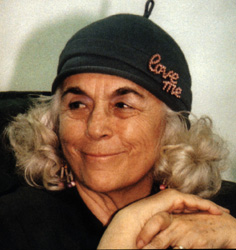The directory «Plots»
Gaite Carmen Martin
(1925—2000)

Carmen Martín Gaite was born in Salamanca on December 8, 1925. She graduated from the University of Salamanca in Philosophy and Letters where she met Ignacio Aldecoa and Augustín García Calvo. It is in this university that she has her first contact with theater participating as an actress in various shows. She collaborated with many magazines such as "Trabajos y Días" en Salamanca and "Revista Nueva" in Madrid. She moved to Madrid in 1950 and received her doctorate at the University of Madrid with a thesis entitled "Usos amorosos del XVIII en España" (Love in 16th Century Spain). Ignacio Aldecoa, whose works she would study later, brought her in to his literary circle, where she met Josefina Aldecoa, Alfonso Sastre, Juan Benet, Medardo Fraile, Jesús Fernández Santos and Rafael Sánchez Ferlosio, with whom she married later in 1954. It was in this way that she was included in a group of writers who would be considered as the Generation of 55 or the Post War Generation.
She wrote her first short story, "Un día de libertad", in 1953, although she confesses to writing from as early as 8 years old. Her literary career begins when "El balneario" received the Café Gijón award, one of the most prestigious literary awards in Spain. Three years later she publishes what would be an incomparable work, "Entre visillos" and it is presented for the Nadal Awards and wins. She wrote two plays, the monologue "A palo seco" en 1957, which was represented in 1987; and "La hermana pequeña" in 1959, rescued in 1998 by theater director Ángel García Moreno, and which opened the 19th of January 1999 in Madrid.
During the 60's she continued to cultivate the narrative, with important works such as "Las ataduras" (1960) or "Ritmo lento" (1963), but it is in the 70's when we see the real versatility of Martín Gaite. She publishes her theories about the process against Macanaz and in addition to her thesis, a recompilation of her poetry in "A racha" (1976), and one of her best works, the novel "Reathilas", is released in 1974. Her first recompilation of short stories is also published in this decade, "Cuentos completos". Her journalistic phase is characterized by a period of time as an editor in the beginnings of the newspaper Diario 16.
Her marriage to Rafael Sánchez Ferlosio only lasted a few years, only to end in separation. They had a daughter Marta to whom she dedicated the story "La reina de las nieves" (The Snow Queen) Her daughter preceded her in death. Among other achievements Martín Gaite is known for being the first woman to be granted the National Literature Award with "El cuarto de atrás" in 1978, and for having received the Premio Nacional de Letras for her life's work.
She was one of the most and best awarded authors of the literary world; she obtained the Príncipe de Asturias Award in 1988 shared with the Galician poet José Angel José Ángel Valente [1929-2000], the Premio Acebo de Honor awarded to her life work, the Award Premio Castilla y León de las Letras in 1992, the Medalla de Oro del Círculo de Bellas Artes in 1997 and the Pluma de Plata del Círculo de la Escritura was given to her in June of 1999, whose ceremony was transmitted by video-conference on Internet, something without precedent in the literary world until that moment . With her essay "Usos amorosos de la psguerra española" she received the Anagrama Essay Award in 1987 and the Golden book award from the Spanish booksellers. This work increases sales of all her works, and from then on Carmen Martín Gaite's works are always among the best sellers in Spain, noting her spectacular success in the Madrid Book Fair where her work is often the most sold in the whole fair.
She cultivated literary criticism as well as translations focusing on authors such as Gustave Flaubert [1821-1880], Rainer Maria Rilke [1875-1926] and Emily Brönte [1818-1848]; and personally collaborated in the scripts for television series for Spanish television, such as Santa Teresa de Jesús (1982) and Celia (1989), a children's series based on the famous short stories of Madrid writer Elena Fortún (1886-1952).
She gained public and critical success with the publication of "Lo raro es vivir" in 1997 and "Irse de casa" in 1998. In 1999 "La hermana pequeña" is published and presented and, with the collaboration of Emma Marinell Gifre, she compiles in "Cuéntame", writings and shorts stories written between 1953 and 1997. In 2000 she is diagnosed with cancer and which ends her life a short month and a half later on July 23 in a clinic in Madrid. She is buried in El Boalo, where she lived with her family in her later years and where her daughter and her parents are also buried.
Spain, 2008, Carmen Martín Gaite